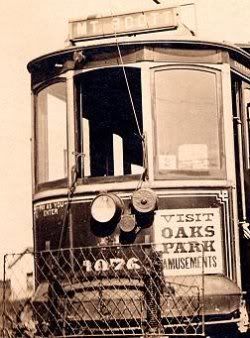
One of the Expo lamps is to the left, the willow-tree-looking thing, there.
After its 1st year of operation, the park was jointly managed by the OWP and the newly incorporated Oaks Amusement Company. The OAC leased the park from the railway for $35,000, w/ the OAC maintaining the grounds & managing concessions. However, the OWP, typical of rail interests in Portland at the time, reaped the lions share of profits, earning 5 cents each way in trolley fares & 10 cents per admission, on top of the $35,000 it was collected from the OAC. The OAC, in contrast, only collected a % of concessions income.
The year construction of the Oaks began, the 2 Portland city-only trolley companies - City & Suburban Railway and Portland Railway - had merged to become Portland Consolidated.3 In 1905, Portland Consolidated was sold to east coast interests & re-renamed Portland Railway Co.

A Portland trolley w/ advert for Oaks Park.
In 1906 Portland Railway & the OWP merged to become Portland Railway, Light & Power Co. PRL&P assumed ownership of the Oaks on June 29, 1906, & the managing Oaks Amusement Co. was dissolved in the spring of 1907. D.C. Freeman, who had worked in the administration of Lewis & Clark Exposition, was made manager of the park.

Local entertainment mogul John F. Cordray leased the park in 1909, giving the Oaks more leverage w/ the local papers & City Hall. In the 1920s, laws were passed prohibiting electric companies like the PRL&P from owning amusement parks, making the "trolley park" phenomena an anachronism, & Cordray purchased the Oaks outright.4

A trolley is visible in the distance of this view.
Although Oaks Park proudly marches on to this day, if I were to make some changes, I'd like to see (a) one decent roller coaster, & (b) a real slammin' video arcade. I mean, Avalon on Belmont is great & all, but the selection can be a bit stale5, & I'm not always in the mood to deal w/ the Bourbon Street-esque flavor surrouding Ground Kontrol on a Friday or Saturday night.6 While they're at it, can they rebuild the Oaks Tavern?7
-d.d.
1 Sellwood Park had been a potential location for the Expo. So was Ross Island (imagine how different the city might be if that had happened) and 'Hawthorne Park,' a large open space between Hawthorne and Division and 9th & 12th.
2 Purportedly one of the Expo lamps still works and is on display in The Oaks Museum. This past summer I wandered the entire Oaks property & I believe that this building is (or was) the "museum," but it was neither open nor appeared to have been for some time. Peeking thru the windows, I spied old pictures on the walls w/ description cards under them, but that was it.
3Abridged History of Portland's Trolley Years.
1891: The City & Suburban Railway Co. acquires a fistful of smaller trolley companies to become largest streetcar company west of the Mississippi
1892: The Portland Consolidated Street Railway Co. emerges as the counterpart to the City&Suburban.
1893: The East Side Railway Co. completes 1st electric interurban line in the U.S. between Portland & Oregon City.
1896: Portland Consolidated goes bankrupt & is purchased by Portland Railway Company.
1901: East Side Railway Co. sold in foreclosure & eventually emerges as Oregon Water Power & Railway Co. by 1902.
1904: Portland Railway and City & Suburban merge, forming Portland Consolidated Railway.
1905: Portland Consolidated Ry. sold to east coast interests for $6million & name changed to the (second) Portland Railway Co.
1906: Portland Railway consolidated w/ Oregon Water Power & Railway to become Portland Railway, Light and Power Company. PRL&P presided over a system of 28 streetcar & interurban lines, zenith-ing in the years just prior to World War I.
1924 PRL&P changes name to Portland Electric Power Company (PEPCO), but lines remained essentially the same. Although PEPCO operated 3rd largest narrow gauge streetcar system in the US, growth slowed during the 1920s as cutbacks in service & labor, such as remodeling equipment to facilitate one-man car operation, became the norm.
4 For more info on Oak's Park, see Sara Paulson's The Oaks in the Progressive Era.
5 By "stale," of course, I actually mean "too new." As in, everything's a racer or a shooter. & they took away Virtual On. What happened to the side-scroller shooter? Metal Slug, anyone?
6 Or the pre-emptive heavy police presence.
7 see The Oaks Tavern (1905-1920s), June 16, 2006.
